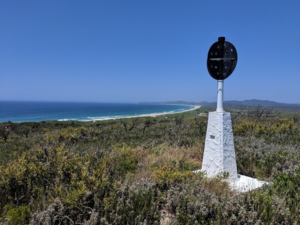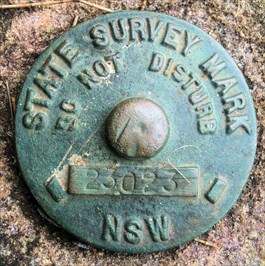Trigpoint
| This page contains information specific to Geocaching Australia. |
Contents
General Information
A trig point (also known as a Trigonometric Station) typically consists of a black disc on top of four metal legs or concrete pillar, resembling a navigation beacon. It is also accompanied by a metal disc, which is located directly below the center point of the tripod or on top of the pillar itself. A national geodetic survey and adjustment carried out in the early 1970s in Australia has left a legacy of trig stations, many consisting of a ground mark with a black quadripod supporting a white square disc above the ground mark Trig points are generally located at the top of hills or points of prominence in the landscape. Many provide unique views and challenges, with some being difficult to get to. These points were regarded as valuable to surveyors, providing reference points for measuring distance and direction, and assisting in the creation of maps. The station is usually set up by a government with known coordinates and elevation published. Many stations are located on hilltops for the purposes of visibility. A graven metal plate on the top of a pillar may provide a mounting point for a theodolite or reflector. Trigonometrical stations are grouped together to form a network of triangulation. Positions of all land boundaries, roads, railways, bridges and other infrastructure can be accurately located by the network, a task that is essential to the construction of modern infrastructure. Apart from the known stations set up by government, some temporary trigonometrical stations are set up near construction sites for monitoring the precision and progress of construction. Some trigonometrical stations use the Global Positioning System for convenience; however, the accuracy depends on factors such as ionospheric and tropospheric propagation delay errors. Although stations are no longer required for many surveying purposes, they remain useful to hikers as navigational aids. Trig points or Triangulation Pillars are another way of spotting the top of a mountain on a map. The symbol for a trig point is a small triangle. They are real concrete pillars that are placed at particular places which are usually the tops of hills or mountains.
Trig Points
Trig Points listed on GCA are, as mentioned above, a structure designed to aid in surveying. A photo follows:
http://geocaching.com.au/gallery/images/tp0584/8161674138.jpg
The structure is generally as above but can vary between states. In some cases a building (such as a lighthouse) forms the trig point.
Benchmarks/Survey Marks
A benchmark/survey mark is a bronze disc which is also used by surveyors and are either points of known location (latitude/longitude) or height. A trig point will always be associated with a survey mark, however survey marks can be independent of a trig point. A sample is shown below:
http://geocaching.com.au/gallery/images/tp1931/3891674124.jpg
There are many (in the hundreds of thousands) of benchmarks/surveymarks around Australia. As this is the case, it was decided only to list actual trig points, rather than add hundreds of thousands of listings into the database. There is another option, however, for people whom wish to log such entities. There are locationless cache categories for almost all states for logging state survey marks. So if you have found only a benchmark and not a trig point, then you can still log them! Links follow:
Logging a Trig Point
To log a find on the Geocaching Australia website, you will need to include a picture of the trig point, along with your GPS receiver and (preferably) yourself. Long distance / telephoto type pictures are against the spirit of this cache. You are encouraged to leave a description of your journey in your log to help others in finding the trig point.
To discover how to add a picture to your log, see the Gallery page.
Editing a Trig Point
If you feel that you can add to the description of this trig point or adjust the difficulty / terrain ratings, please feel free to edit this cache and amend the information suitably.
If you wish to edit the Trig Point listing page then simply click "Edit this cache" from the Community Actions menu on the right hand tab. You will then be shown the standard cache listing page where you can edit any of the information about the trig point. If there is any valuable information you can add to the page (such as need to use a 4x4 for access or watch out creepy crawlies or snakes) then we encourage you to include this in the cache description.
Feel free to edit any of the fields on the cache listing page. The more information about a Trig Point we can get the better. The names of trig points have been automatically generated from their location. If you can rename this and rework their descriptions for future finders that would be greatly appreciated. http://wiki.geocaching.com.au/images/a/aa/Editing_Cache.jpg
Archiving
If you believe that a trig point is located on private property or in a dangerous location, you may archive the cache, by clicking on Log this Cache and place an "Archived" log on the Geocaching Australia website.
Listing
If you believe you have found an unlisted TrigPoint you are welcome to list it via https://geocaching.com.au/my/cache/new
Some things to check:
- Check that the TrigPoint hasn't been previously listed and has been archived for any reason including private property, damage or owner request.
- Check it is a valid TrigPoint and not s Survey mark. TrigPoints have a beacon and / or a marker marked Trigonometrical Station. If in doubt, post in the Geocaching Australia forum where others will help in determining if what you have found is a TrigPoint.
Then simply create a new Geocaching Listing and in the TYPE field, make it a TrigPoint. Once you save the listing it will be AUTOMATICALLY published, but as anyone can edit the listing, feel free to make any corrections.
Note:
- If you mark the geocache as anything other than a TrigPoint you will NOT be able to change the geocache type, so this is most important to set correctly before you save.
- The TrigPoint will owned by Geocaching Australia. If you would like to have your name associated with the listing then include your name in the "Placed By" field.
External Trig Databases
Australian Capital Territory
For those interested in sourcing some Trig Stations in the ACT the following link takes you to the ACTPLA website with a further link to the Survey Mark Database. Trigonometrical Stations are identified in the database by the code "MC". https://app2.actmapi.act.gov.au/actmapi/index.html?viewer=survey
New South Wales
Trig Stations in NSW appear on NSW Government's SIX Maps Page. Trigs are marked with a small triangle and labelled with their registration number and site name. A trig with a 'D' at the end of it's registration number has been identified as destroyed.
Queensland
QLD survey marks (including Trigs) are available on the Queensland Globe website. Survey Marks do not appear on the online map by default, so one must turn it on in the list of map layers.
Remember
The original collection of trig points has been sourced from Geoscience Australia and may contain inaccuracies.
Please respect local laws and regulations when searching for trig points.


